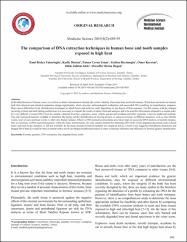The Comparison of DNA Extraction Techniques in Human Bone and Tooth Samples Exposed to High Heat

View/
Access
info:eu-repo/semantics/openAccessDate
2019Author
Yükseloğlu, Emel HülyaDastan, Kadir
Yonar, Fatma Cavus
Rayimoglu, Gülten
Karatas, Ömer
Islek, Dilek Salkim
Doğan, Muzaffer Berna
Metadata
Show full item recordCitation
Yukseloglu, E. H., Dastan, K., Yonar, F. C., Rayimoglu, G., Karatas, O., Islek, D. S., & Dogan, M. B. (2019). The comparison of DNA extraction techniques in human bone and tooth samples exposed to high heat. Medicine, 8(2), 489-95.Abstract
In the identification of forensic cases, it is critical to obtain information to identify the victim’s identity from burnt bone and tooth remains. When bone and tooth are burned, both their physical and chemical properties change significantly, which prevents anthropological evaluations and successful DNA profiling for identification purposes. Heat causes difficulties in the identification techniques in which bones and teeth are used, depending on the degree of heat exposure. For this reason, with the changes occurring in bone and tooth during combustion, it is necessary to evaluate the results of observation and analysis, and to be used the information obtained in a certain order. It is very difficult to extract DNA from the samples obtained from fire, explosion, motor vehicle and aircraft accidents and other traumatic events by traditional methods. The only biological material available to determine the typing and the identification of missing persons or unknown remains in different situations, such as mass fatality events, wars or socio-political events, is often only human remains. Effective DNA extraction procedures are critical steps in successful DNA analysis of skeletal remains. Due to variations in DNA and heterogeneity within the bone, unfortunately, the only reliable method for obtaining DNA from overly degraded specimens such as burnt bones and teeth in the literature, is still not available. In the study, present extraction methods are compared and as a result it was suggested that phenol-chloroform and Qiagen DNA Mini Kit could be used in routine with a newly developed modified procedure in order to increase efficiency and efficiency in forensic genetic identification.

















